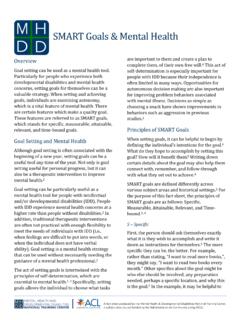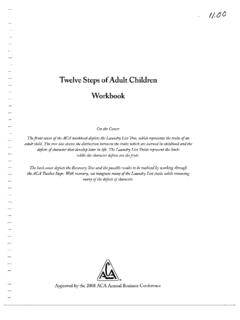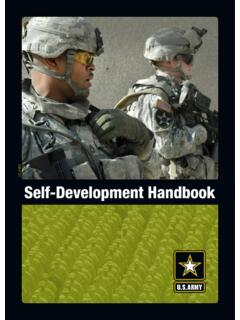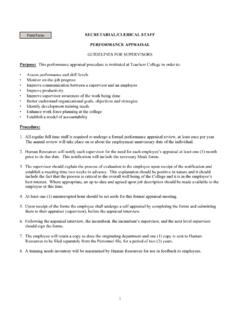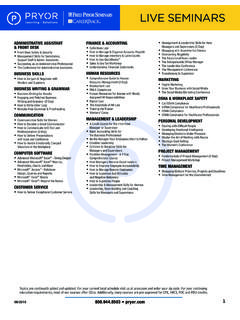Transcription of Using a Strengths-Based Therapeutic Approach with …
1 Using a Strengths-Based Therapeutic Approach with People with Developmental DisabilitiesOverview A Strengths-Based Approach is one that focuses on the strengths and resources of the client, rather than their problems or Thorough understanding of the client s mental health issues, limitations and barriers is important in the process of assessment and treatment, a Strengths-Based Approach goes beyond this to identify the person s functional strengths, desired life experiences, ambitions, wants, resources, and support Often times, developmental disabilities are viewed from a medical model, which suggests that disabilities should be cured , and symptoms should be eliminated.
2 A Strengths-Based Approach , however, suggests that features of disability represent natural differences and that developmental disabilities give people unique strengths that are important to their To emphasize this concept, it is important to use Strengths-Based language rather than deficit- based language. For example, instead of saying a person with a disability is stubborn, that can be rephrased to say the person is perseverant; instead of saying a person is hyperactive, rephrase that to say the person has zest and curiosity. Using a Strengths-Based Approach and language helps clients see that their disabilities contribute to their positive A Strengths-Based Approach is also person-centered, meaning that the mental health provider trusts that the client is the expert on their own life and follows the client s lead.
3 In this Approach , the provider listens to the client with empathy and without judgement. The goal of a person-centered Approach is to help the client experience self-discovery and come up with solutions that are unique to their specific context and , 8 Using this Approach in therapy can help people with disabilities understand that they can exercise their own autonomy and use their unique strengths to reach their goals. Many models of therapy such as Narrative Therapy, Positive Psychology and Solution-Focused Therapy are person-centered and Strengths-Based . However, even if you do not primarily use these models, it is still possible to integrate Strengths-Based and person-centered principles and interventions into your practice.
4 This is done by empowering clients to be self-determined and then facilitating specific interventions to help clients identify and utilize their strengths. Empowering Clients to Be Self-Determined Self-determination is a person s ability to act for themselves, pursue goals, face challenges and learn from This is important in a Strengths-Based and person-centered Approach because a client has to believe in their ability to reach their goals in order to make progress. Unfortunately, people with developmental disabilities are not given many opportunities to strengthen their own self-determination because people often wrongly assume that they are not able to do things on their As their provider, you can help them foster self-determination by demonstrating that you believe in their competence and abilities.
5 Some ways to do this include: Giving them choice and control in the therapy process Using age-appropriate communication Supporting clients in demonstrating their strengths Encouraging them to look for their own solutions and helping them see how they have come up with solutions in the past Allowing the client to speak for themselves2 Interventions to Identify and Utilize Strengths In addition to fostering self-determination in therapy, there are various interventions that can be done to help clients recognize and build upon their unique strengths. First, the Assessment Scale for Positive character Traits- Developmental Disabilities (ASPeCT-DD) can be a helpful tool to measure the presence and strength of positive character traits for people with developmental There is also a questionnaire called the Values in Action (VIA) inventory of Strengths, which identifies a person s signature strengths and ranks them from most to least If you are unable to access these assessments, there is also an activity called strengths spotting, where the provider helps the client identify and find evidence for their own strengths.
6 As a supplement to this, the provider can also involve others such as family members or caregivers to help identify the client s After positive traits are identified, it is important to give the client opportunities to use and build upon these strengths. There are various interventions that can facilitate this such as gifts of time, counting kindness, Using your signature strengths in new ways each day, best possible self and overuse and underuse. Gifts of time is an intervention that encourages clients to use their strengths to serve others by Using their time to help three people the client would not have otherwise Similarly, in the counting kindness intervention, clients count the number of kind acts that they perform each These interventions focused on serving others helps people with developmental disabilities strengthen their relationships with others because they help to increase a feeling of reciprocity in the relationships.
7 This helps people with developmental disabilities develop more confidence in their contributions to relationships since they are often forced into roles of needing help rather than giving Next, the intervention of Using your strengths in new ways each day is meant to be used with the signature strengths that are identified Using the VIA inventory of Strengths. The client is supposed to pick one of the strengths that ranked the highest on this assessment and use it in a new way each day for one Another intervention is called best possible self, which encourages the client to imagine a certain point in the future where they have reached their goals and discuss the strengths that they could use to reach that best possible self they have Lastly, the overuse and underuse intervention helps clients balance out their strengths.
8 For example, if the client struggles with procrastination, they may be overusing their strengths of curiosity and having fun, while they may be underusing their strengths of wisdom and Most of these Strengths-Based interventions have shown to be associated with increased happiness and decreased Conclusions Rather than overly focusing on the problem in therapy, a Strengths-Based and person-centered Approach encourages the provider to emphasize on and build upon the person s strengths, give the person more control and autonomy in therapy, and foster self-determination. Using this Approach in therapy can provide opportunities for the client to practice autonomy, increase their own happiness, improve their relationships with others and increase confidence in their strengths and , 3, 5 Contributing Authors Raechel Russo, , LMFT Candidate References 1.
9 Buntinx, W. H. (2013). Understanding disability: A Strengths-Based Approach . The Oxford handbook of positive psychology and disability, 7-18. 2. Donaldson, A. L., Krejcha, K., & McMillin, A. (2017). A Strengths-Based Approach to autism: Neurodiversity and partnering with the autism community. Perspectives of the ASHA Special Interest Groups, 2(1), 56-68. 3. Gander, F., Proyer, R. T., Ruch, W., & Wyss, T. (2012). strength - based positive interventions: Further evidence for their potential in enhancing well-being and alleviating depression. Journal of Happiness Studies, 14(4), 1241-1259. 4. Meevissen, Y. M., Peters, M. L., & Alberts, H. J. (2011).
10 Become more optimistic by imagining a best possible self: Effects of a two-week intervention. Journal of behavior therapy and experimental psychiatry, 42(3), 371-378. 5. Niemiec, R. M., Shogren, K. A., & Wehmeyer, M. L. (2017). character strengths and intellectual and developmental disability: A Strengths-Based Approach from positive psychology. Education and Training in Autism and Developmental Disabilities, 52(1), 13-25. 6. Otake, K., Shimai, S., Tanaka-Matsumi, J., Otsui, K., & Fredrickson, B. L. (2006). Happy people become happier through kindness: A counting kindnesses intervention. Journal of happiness studies, 7(3), 361-375. 7. Peterson, C.
